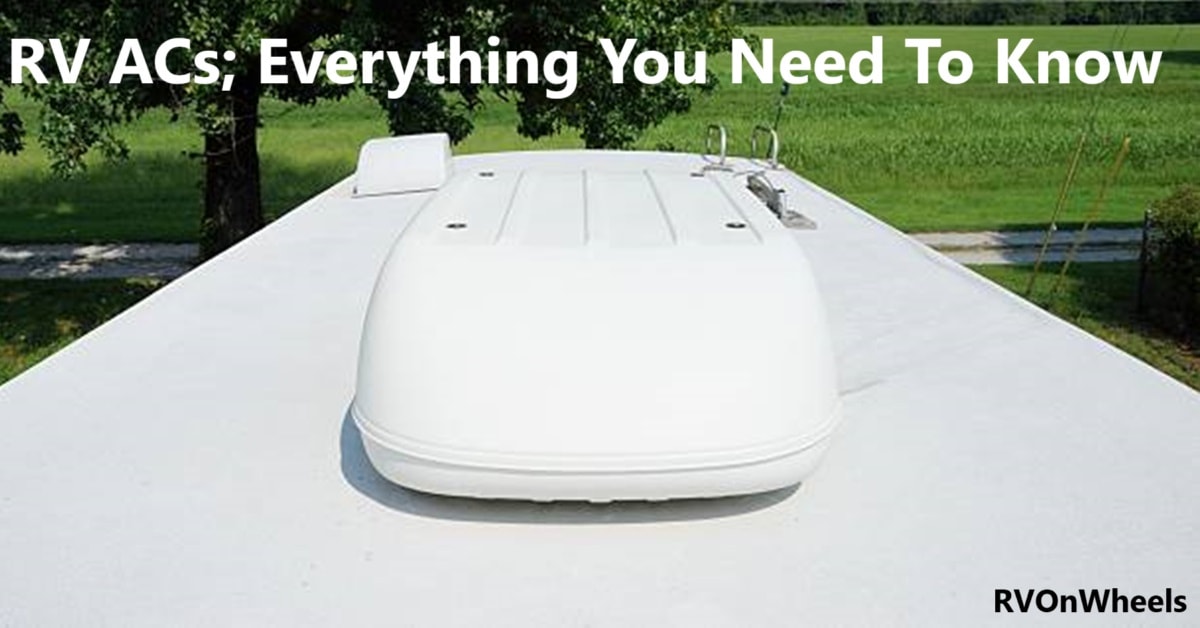Ready to beat the heat on your RV adventures? Whether you’re shopping for a top-notch RV AC or looking for a foolproof installation guide, you’re in the right place.
Buying a Camper AC costs a lot, and you don’t want to waste your money on an unreputable brand. Here, we will share a detailed guide about the top RV AC brands in 2024. Moreover, we will share the step-by-step installation process so that you can install the AC on your own.
This blog post will teach you everything you need to know about Travel Trailer ACs. After reading it, you will know how to troubleshoot some common issues with the AC. Let’s quickly get into the details of this guide to help you find the best Portable AC for you!
Types of RV AC Units
There are several types of RV air conditioners. All of them have their unique features and are used for different purposes. Understanding the types of AC can help you choose the best option for your travel needs. Common types include:
Low Profile Air Conditioners
These air conditioners are small and unnoticeable. They are usually installed on the rooftop and look so sleek that they blend in with the RV. They are best for RVs with low clearance or those wanting a sleeker look.
Heating And Cooling Units
These are hybrid AC units to provide both heating and cooling to your RV. They are more expensive than other types of air conditioners, but they offer convenience in both seasons, summers and winters.
Wall-Mounted Air Conditioners
These units are installed inside the RV and are designed to be more permanent than portable units. They require a hole to be cut in the RV wall, but they offer a more streamlined appearance.
Rooftop Air Conditioners
Rooftop ACs are the most common and widely used RV AC units across the USA. They are installed on the trailer rooftop. These units are powerful enough to cool the entire vehicle. Before Installation, make sure your RV roof is sturdy enough to hold the weight of the AC unit.
Portable Air Conditioners
These units are lightweight, portable, and can fit in small places. These are less powerful compared to the standard ACs and require a window or vent to remove the hot air inside the RV. They are the cheapest air conditioner units in the market, ranging from $300 to $700. You can buy these from Walmart.
Window Air Conditioners
Window AC units are similar to the standard ACs used in homes but are smaller and designed to fit RV windows. These AC units are easy to install, making them a flexible option for RVs. These units are installed in a window, with a part of the unit inside the RV and part outside. They’re more affordable compared to the rooftop or under-bench models. Due to their small size, they are not suitable for larger RVs. As of September 2024, you can buy these from Amazon costing $150-$200.
Under Bench/Inside-Mounted AC Units
Under bench/inside-mounted RV AC units are small ACs that are designed to fit inside the RV rather than rooftop. These ACs are installed under a bench or seat or inside a storage cabinet. They take up less space and are quieter than rooftop AC units. Usually, these ACs are less powerful than larger rooftop models.
These units are ideal for smaller RVs. The Installation of bench AC units requires careful consideration of ventilation and drainage. They need 12V DC power to operate, making them compatible with RV electrical systems. Currently, these AC units cost between $340-$420. You can buy them from Alibaba.
Ducted and Non-Ducted AC Systems
Ducted systems provide more consistent cooling throughout the RV, while non-ducted systems are designed for individual rooms only. Ducted systems are usually more expensive to install because they involve cutting into walls, ceilings, and floors, which is time-consuming. Non-ducted systems are generally more affordable, but they are not good for larger vehicles.
How To Choose The Right RV AC?
Choosing the right RV air conditioner might be confusing, as many models are in the market. However, some factors will help you make a choice. Let’s discuss these factors:
RV Size
The biggest factor in choosing the right RV AC is the size of your recreational vehicle. It takes more power and energy to cool a larger space. A small rooftop AC unit installed in a large trailer can take too long to cool the interior— and it might not even get the job fully done.
On the other hand, if you have a small van and you end up buying a large AC unit, it is a waste of power and money. Plus, if you go too large, the power draw can be too much for your RV, leading to electrical damage.
Efficiency
The more efficient an RV AC unit is, the more enhanced air-cooling you get. The efficiency of an AC is measured in Energy Efficiency Ratio (EER) ratings; the higher the rating, the more energy-efficient the unit is. A higher efficiency rating means the AC consumes less power to cool the same area, saving you power and reducing the time it needs to run.
Durability And Reliability
When choosing an AC, ensure it is durable and reliable to withstand harsh travel conditions. Look for air conditioners with vibration-resistant technology. Additionally, consider units whose spare parts are available in the market so that if repairs or replacements are needed, you can easily find the necessary components. Reliable warranty coverage is also essential for peace of mind.
Noise Level
Another factor to consider is the noise level of the air conditioner. Excessive noise from the AC can be irritating. A quiet RV air conditioner ensures a peaceful and enjoyable travel experience. Look for units specifically designed with noise reduction features.
Understanding BTU (British Thermal Unit)
British Thermal Unit, or BTU, is the unit used to measure thermal (heat) energy. In terms of an air conditioner, BTU is an energy metric that refers to the heat an AC can remove from a space at a specific time. Knowing the BTU levels is essential before purchasing a portable AC unit.
Higher BTU ratings mean more cooling power and lower BTU ratings mean less cooling capacity. AC, with a higher BTU rating, is suitable for managing larger or hotter spaces. Choosing the right BTU ensures your AC unit can efficiently handle the size of your RV, providing optimal comfort without excessive energy use.
We would recommend using the BTU cooling calculator to determine the specific amount of BTUs you will need from your air conditioner in order to properly cool your space. However, below is a list of some general BTU recommendations that will help get you started.
BTU Chart Based on Room Size
| Room Size | BTU’s Needed | Room Size | BTU’s Needed |
|---|---|---|---|
| 150 sq. ft. | 5,000 BTU’s | 700 sq. ft. | 14,000 BTU’s |
| 250 sq. ft. | 6,000 BTU’s | 1,000 sq. ft. | 18,000 BTU’s |
| 300 sq. ft. | 7,000 BTU’s | 1,200 sq. ft. | 21,000 BTU’s |
| 350 sq. ft. | 8,000 BTU’s | 1,400 sq. ft. | 23,000 BTU’s |
| 400 sq. ft. | 9,000 BTU’s | 1,600 sq. ft. | 25,000 BTU’s |
| 450 sq. ft. | 10,000 BTU’s | 1,900 sq. ft. | 28,000 BTU’s |
| 550 sq. ft. | 12,000 BTU’s | 2,700 sq. ft. | 36,000 BTU’s |
Energy Efficiency Considerations
Choose air conditioners with a high Seasonal Energy Efficiency Ratio (SEER) rating for better cooling with less energy. On average, an RV air conditioner consumes between 11 and 16 amps. Energy efficiency also comes into play. You can have two AC units of the same size, but the more efficient model will usually draw fewer running amps.
These are some of the top energy-efficient RV ACs. These models boast 25-40% better efficiency than the standard RV air conditioner units. Let’s take a look at the top picks.
- Atwood Air Command
- Coleman-Mach 3 Power Saver
- Furrion Chill
- Dometic Penguin II High Efficiency (Low Profile)
Budget Considerations
The cost of an RV AC varies depending on the type and model, as well as the features and amenities. It’s important to set a realistic budget and stick to it. You should also consider potential installation costs, especially if professional help is needed.
Tips for Reducing Noise
Noise from an RV air conditioner can affect your comfort and travel experience. Excessive noise is irritating and disrupts sleep and conversation, making your journey less enjoyable. It’s essential to consider an AC model with built-in Noise-reduction technology to ensure a peaceful environment inside your RV. These are some tips to reduce noise from your RV AC.
- Install Sound Dampening Materials: Use materials like acoustic panels or foam to absorb and reduce noise.
- Ensure Proper Installation: Secure the unit correctly to minimize vibrations and rattling.
- Regular Maintenance: Keep the AC clean and well-maintained to avoid any additional noise from dust or wear.
Top RV AC Brands and Models
Choosing a Travel Trailer AC brand is a confusing task, as there are many brands and models in the market. However, few of them stand out than others for obvious reasons. Which are these brands? And what are their best models? We have got you covered. Here are the best-performing AC brands in the market:
1. Dometic RV Air Conditioners
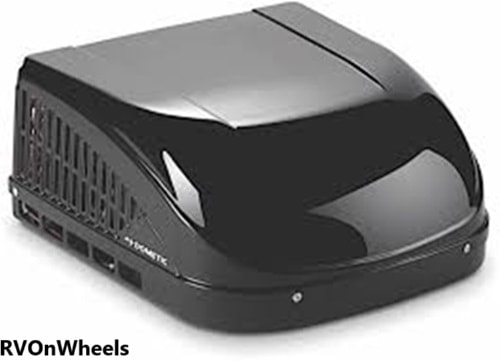
Dometic is a renowned brand known for its high-quality and reliable air conditioners. Their main focus is on innovation and durability. Dometic offers a range of products designed to enhance comfort and convenience in RVs.
Best Model and Its Features
The Dometic Brisk II is one of the brand’s hottest products. It offers a powerful cooling capacity of up to 15,000 BTU, ensuring moderate temperature inside the RV. The Brisk II is known for its compact design, noise reduction technology, and efficient airflow, making it a popular choice among RVers. You can buy it from Amazon for $1499 per the current pricing.
Dometic Reviews and Ratings
Dometic air conditioners are top-selling ACs and have an average rating of 4.2 out of 5 stars on Amazon. With their superior airflow, cooling capacity, and weight, Dometic Acs set the standard for RV rooftop air conditioners. They have a smart design made with improved materials to ensure efficient performance in any climate.
2. Coleman Match RV Air Conditioners
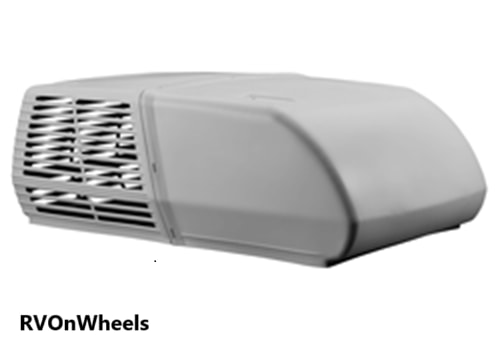
Coleman is a well-established brand in the RV industry known for reliability and performance. It was founded in 1967. Today, Coleman offers superior cooling with a wide range of AC designs.
Best Model and Its Features
Their highest-rated model is the Coleman Mach 15, which is renowned for its high cooling capacity of 15,000 BTU. It comes with a sleek design, a high-efficiency compressor, and a powerful air delivery system. The Mach 15 is known for its durability and comes with a noise reduction technology that reduces the noise from the unit. As of September 2024, the price of Mach 15 is $1359 on Amazon.
Coleman Reviews and Ratings
The Coleman Mach 15 is praised by customers for its durability and strong cooling performance. It’s rated 4.1 out of 5 stars on Amazon, with a 414 global rating.
3. Furrion Chill RV AC Units
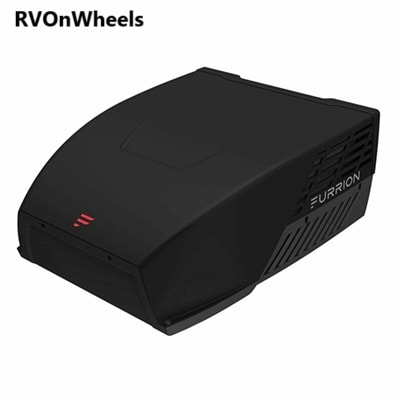
Furrion Chill offers a wide range of rooftop RV air conditioners. They are known for manufacturing the highest energy efficiency and cooling capacity units available on the market. Their camper air conditioner can withstand the toughest weather conditions. They also offer manual, single-zone, and multi-zone controls to suit your Camper AC and comfort needs.
Best Model and Its Features
The standout model is the Furrion Chill HE RV Roof Air Conditioner. It has a 14.5K BTU cooling capacity. It features a sleek, aerodynamic design to reduce air resistance and improve efficiency. The unit features VibrationSmart™ technology that reduces vibrations and noise, ensuring a quieter and peaceful environment. It is designed to be energy-efficient and easy to install. You can buy this unit in 2024 from their official store for $1031.
Furrion Chill Customer Reviews and Ratings
The Furrion Chill is praised for its efficiency, quiet operation, and modern design. Many customers have shared their positive experiences using this unit. It is rated 3.6 out of 5 stars on Amazon, with a 94 global rating.
4. Advent RV AC Units
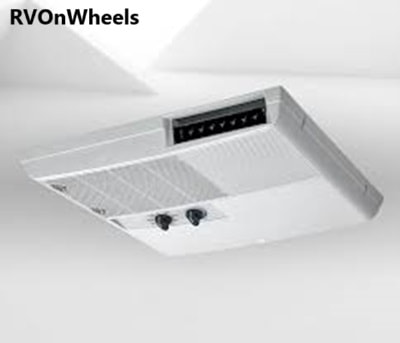
Advent® Air aims to ensure a comfortable RV experience. Their ACs are designed to provide maximum airflow and efficiency while reducing compressor noise for a cool, quiet camping experience.
Best Model and Its Features
Their top product is ASA Electronics ACM135 Advent Air 13,500 BTU Rooftop AC; it comes with 13,500 BTUs and 115 Volt AC power. It has a rigid, metal-constructed base pan. With three fan speeds, it can be installed in a standard 14.25″ x 14.25″ vent opening. In 2024, you can easily get it from Amazon for $1359.
Advent Customer Reviews and Ratings
Customers liked the value of the air conditioner, mentioning it’s a good product. It generally receives positive reviews, 3.9 out of 5 stars, and 114 global ratings.
RV AC Installation Complexity
When it comes to installing an RV air conditioner, understanding the Installation’s complexity and requirements is crucial for ensuring a smooth and successful setup. The Installation varies from model to model. Here, we will guide you through the essential aspects of installing your RV air conditioner:
Factors To Consider Before Installation
Before installing an RV air conditioner, it’s essential to consider a few key factors to ensure a smooth installation process. From checking electrical requirements to selecting the right unit size, these considerations will help you avoid common issues and achieve efficient performance.
- Electrical Requirements: Look for the power supply to ensure it meets the AC unit’s voltage and frequency specifications.
- Installation Tools: Make sure you are equipped with all the necessary tools for Installation.
- Moisture and Drainage: Clean and dry the installation area and seal the joints so that the cool air stays in the room. Plan for proper drainage to avoid moisture issues.
Essential Requirements
- The room or cabin you’re planning to install the AC in should have properly functioning doors and windows to avoid air leakage.
- The room should be dust-free to avoid the clogging of filters.
- The room should have enough power supply for the operation of the AC unit.
- The room should be moisture-prone because moisture can cause corrosion and rust in the RV’s components.
- Consider using curtains and a false ceiling in the room to minimize heat transfer from outside to inside.
One of the essential requirements for AC installation is a proper electrical supply. You must ensure the power supply matches the required frequency and voltage for your unit. Also, ensure there are no fluctuations in the power supply.
Tools And Expertise Needed For Self-Installation
Installing an RV air conditioner yourself is tiring, but with the right tools and expertise, it’s very possible. These are some tools you must have to tackle self-installation efficiently and safely.
- Screwdrivers/Nut Drivers
- Hacksaws
- Hand Seamers/Snips:
- Wrenches
- Vices
- Power Drills
- Taps
- Files
- Multimeter
- Pressure Gauges
- Staple Gun
- Nitrogen Regulator
- Psychrometer
- Safety Tools
Step By Step Installation Process For RV AC Units
Installations are the most crucial step. It’s very simple, but a slight mistake can lead to costly repairs. But you don’t have to worry about that; we have a complete guide on how to install the AC step by step. Follow these steps carefully to avoid any inconvenience.
- Turn off all power sources to your RV to ensure safety during Installation.
- Use a screwdriver to remove the bolts and old sealant from the existing AC unit.
- Carefully lift and remove the old AC unit from the roof of your RV.
- Clean the area thoroughly, remove any dust and debris, and inspect for holes or damage.
- Apply sealant to any holes and ensure all edges around the opening are properly sealed.
- Position the new AC unit over the opening, being careful not to drag it across the roof.
- Align the AC unit with the opening and use a screwdriver to tighten it securely.
- Check that the return air and cooled air paths are separate; insulate any gaps to prevent mixing.
- Connect the AC unit to the power supply following the manufacturer’s wiring instructions.
- Attach the thermostat to the AC unit, ensuring all connections are secure.
- Seal any remaining gaps around the AC unit to prevent air leaks.
- Tuck away any exposed wires to avoid electrical hazards.
- Turn the power back on and test the AC unit to ensure it’s cooling effectively.
- Adjust any settings on the thermostat to optimize performance.
- Inspect the Installation to confirm the unit is properly aligned and secure.
When To Consider Hiring A Professional?
Installing an RV AC unit can be complex, and there are certain situations where hiring a professional is the best option:
- Lack of Experience
- Complex Installations
- Warranty Concerns
- Time Constraints
- Safety Concerns
- Peace of Mind
RV AC Units Common Problems And Their Solutions
It’s common for problems to arise with your Camper AC. But how to tackle them? Well, we have some tips for you. Below are some of the most common problems and their possible solutions.
RV A/C Not Cooling
One of the common complaints of RV users is Insufficient cooling from their ACs. This can be due to several reasons, such as a low refrigerant level, a faulty compressor, or a dirty condenser.
Possible Solutions
To fix this issue, we recommend cleaning the condenser coil using a soft-bristled brush or cloth. Ensure the electricity is turned off before cleaning the coil.
A/C Airflow Problems
RV air conditioners need proper airflow to cool the interior of the RV effectively. If there’s weak or uneven airflow, it could be due to clogged air filters or a blocked air vent. Regularly cleaning or replacing the air filter and ensuring unrestricted airflow can help prevent this issue.
Possible Solutions
There are two possible solutions for uneven airflow. The first is to clean or replace the air filter. Hopefully, it will work after this, but still, the problem exists; check the air vents for any blockages, like dirt or debris. Remove the dirt and dust and ensure they are unobstructed.
Leaks Or Water Accumulation
The next problem that usually arises is water dripping or pooling inside the RV. This is most likely due to a clogged condensate drain line or a faulty drain pan.
Possible Solutions
This problem can be fixed by regular maintenance which includes regular cleaning of the drain line and inspecting the drain pan. If the pan is damaged, replace it quickly. By following this precaution, you can avoid water-related issues and potential water damage. For detailed information checkout our detailed guide Why Is My RV AC Leaking Water Inside. Here we have discussed it’s potential causes, solutions and much more in detail.
Noisy Air Conditioner
Noisy air conditioners can be quite irritating. An RVer needs a peaceful environment while on the road. However, a noisy AC can disturb the peace, making it difficult to sleep or enjoy. This could indicate a problem with the fan motor, loose components, or a worn-out compressor. Trained technicians can examine the unit and determine the source of the noise, making the necessary repairs or replacements to restore a quieter operation.
Possible Solutions
The reasons behind the noisy AC might be fan motors, loose components, or worn-out compressors. If it’s loose screws, tighten it using a screwdriver. However, it’s better to call an expert to determine the cause of the noise instead of doing it on your own.
Upgrading And Enhancing Your RV AC System
As time passes by your Air conditioner loses its efficiency and cooling capability. Upgrading and enhancing the RV AC can boost its performance. A newer AC model comes with advanced features and increased efficiency, making your RV more comfortable.
Improved Energy Efficiency
Upgrading your Camper AC will provide improved efficiency. Newer models are designed with the latest technologies and are energy efficient, helping you save on electricity costs. It’s a wise investment to upgrade to a more energy-efficient air conditioner, allowing you to enjoy a travel experience without worrying about high energy bills.
Enhanced Travel Experience
During long RV travels, an RVer needs a comfortable environment. Upgrading the RV air conditioner can enhance your overall travel experience by providing a comfortable and cool environment on the road.
Adding Solar Power To Your RV AC
When it comes to a cost-effective way to run an AC, there’s nothing like a solar power system. They convert the solar energy to usable electricity, reducing electricity and generator costs. Also, they operate quietly, unlike generators, which make a lot of noise.
RV AC Maintenance Tips
Regular maintenance is essential to keep your AC running for a long duration. Following are some practical maintenance tips to increase the efficiency and life of your RV;
- Change the air filter at least once a month for efficient cooling.
- Inspect and clean the evaporator and condenser coils regularly.
- Clean the exterior of the AC unit annually, including the shroud and condenser coils.
- Set the thermostat to a moderate temperature to avoid overworking the AC.
- Open the roof vent when the RV is not in use to prevent moisture buildup.
- Oil the fan regularly to ensure smooth operation.
- Cover the AC unit during the off-season to protect it from dirt and debris.
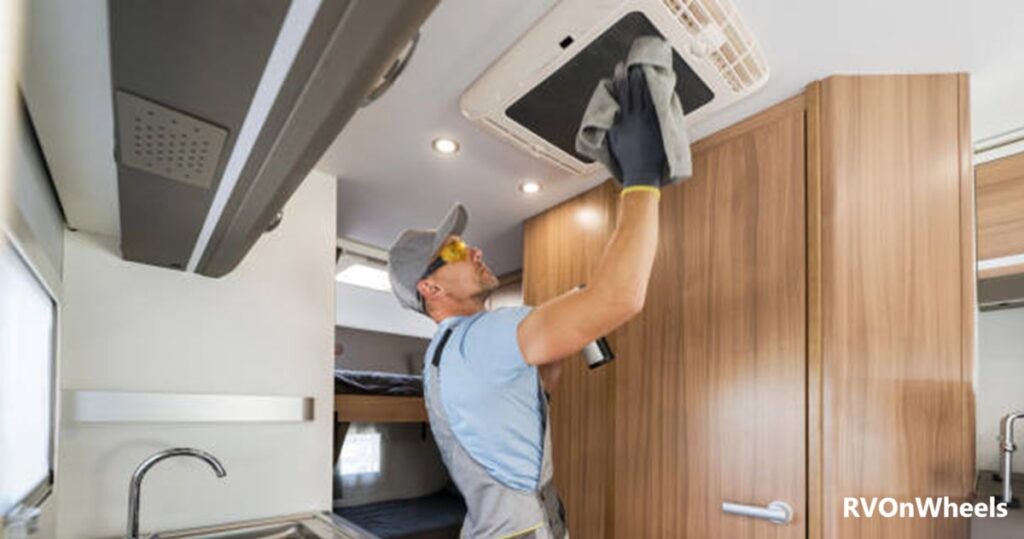
When To Replace Your RV AC Unit?
Replacing your Travel Trailer AC unit can be a big decision, but knowing when it’s time can save you from discomfort on the road. Here are some signs that it might be time to replace your RV’s AC unit:
- Inconsistent Cooling: If you are seeing a noticeable degradation in AC cooling or it’s struggling to maintain a consistent temperature, it’s an indication your AC is reaching its lifespan. That’s the best time to go for a replacement.
- Frequent Breakdowns: If your AC needs frequent repairs, it’s a sign your Travel Trailer AC is reaching its end. Regular repairs are costly and it’s best to replace that unit.
- Strange Noises or Smells: Unusual noises from the Camper AC like banging, grinding, or hissing might indicate serious issues with it. It’s dangerous to continue using the AC unit and these problems often signal internal damage or wear that may be beyond repair.
- Increased Power Consumption: If you notice a significant rise in your RV’s power consumption, it might be due to your AC unit working harder to cool the space. This increased strain not only impacts your power usage but can also be a sign that the unit is no longer operating efficiently.
- The age of the Unit: RV AC units typically last around 10 to 15 years. If your unit is nearing that timespan and you are facing performance issues, this might be an indication that you need a replacement.
- Visible Damage Look for visible damages such as cracks, rust, or broken components on your Camper AC. These damages can affect the unit’s performance and might mean it’s time for a replacement to ensure reliable and effective cooling.
Final Words
This was all about RV AC units. We have aimed to share comprehensive information related to the RV Air conditioners. Hopefully, now you have a good understanding of how an AC unit works and are equipped with enough knowledge you need about RV ACs.
We also have shared some of the best Travel Trailer AC brands and models for 2024. Have a look at them and do your research, compare the prices and specifications. Additionally, if you are looking for a cost-effective alternative to electricity, we recommend using solar panels to power your Camper AC.
FAQs
Can You Run AC With Solar Power In An RV?
Yes, you can use solar energy to run an RV air conditioner efficiently. Solar Panels are an environment-friendly and cost-effective way to generate energy.
How To Clean RV AC?
You can clean your RV AC by following a few simple steps, i.e., Inspecting the AC unit for debris and damages, replacing gaskets and filters, washing inner coils, and cleaning the air filters.
How Many Watts Does An RV AC Use?
Most of the RV ACs consume between 500W for 5,000 BTU units to 2,700W for 27,000 BTU units. Mostly, it comes with the 700W-1,500W. An RV AC average uses 135W of a 13,500 BTU air conditioning unit.
How To Clean RV AC Coils?
You can clean your RV AC Coil simply by turning off the power and accessing the unit to inspect the coils. If there is dust or debris inside, brush the coils gently. Also, replace the coil if required.
How To Reset RV AC?
Press the reset button when the AC turns off, and hold the reset button for 5 seconds. After a few minutes, turn on the AC. Your AC is now reset, and you can adjust its settings according to your needs.
What Size Generator To Run An RV AC?
The size of the generator to run an RV AC simply depends upon the size and type of your RV. Normally, a Generator of 2000-4000W is used to charge a Travel Trailer AC, with a BTU rating of 10,000-15,000.
How Many Amps Does An RV AC Use?
The average Travel Trailer AC consumes between 11 and 16 amps while it’s running. However, at start-up, it consumes 2-3 times more amperes than it does while running.
Why Is My RV AC Dripping Water Inside?
The most common cause of AC leaks is blocked drain holes. Some other reasons might be some broken component inside the AC.
How To Recharge An RV AC Unit?
No, the RV AC cannot be recharged. Camper air conditioning units are closed systems and they do not have refill points.
How To Increase Airflow In RV AC?
The simplest way to increase the airflow in Travel Trailer AC is by opening the windows and roof vents. This allows cross ventilation, allowing fresh air to enter and stale air to exit.
